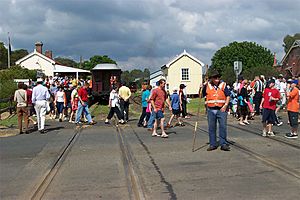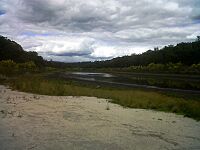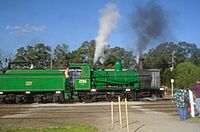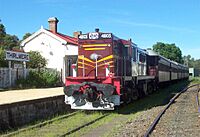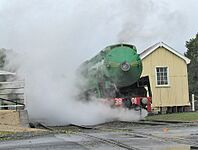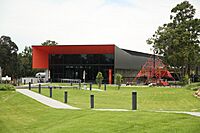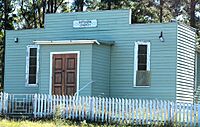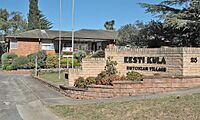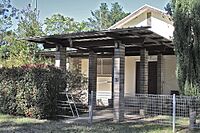Thirlmere, New South Wales facts for kids
Quick facts for kids ThirlmereNew South Wales |
|||||||||||||||
|---|---|---|---|---|---|---|---|---|---|---|---|---|---|---|---|
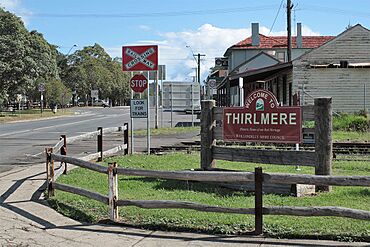
A railway crossing in Thirlmere
|
|||||||||||||||
| Postcode(s) | 2572 | ||||||||||||||
| Elevation | 300 m (984 ft) | ||||||||||||||
| Location |
|
||||||||||||||
| LGA(s) | Wollondilly Shire | ||||||||||||||
| Region | Macarthur | ||||||||||||||
| State electorate(s) | Wollondilly | ||||||||||||||
| Federal Division(s) | Hume | ||||||||||||||
|
|||||||||||||||
Thirlmere is a small town in the Macarthur Region of Sydney, New South Wales, Australia. It's part of the Wollondilly Shire. This town is well-known for its railway history. Thirlmere is located about 89 kilometers (55 miles) southwest of the main part of Sydney. In 2021, about 4,986 people lived in Thirlmere.
Thirlmere was once called Village of Thirlmere. It got its name from a place called Thirlmere in England.
Contents
Thirlmere's Past: A Railway Town
British explorers first visited the Thirlmere area in 1798. They were mainly looking at the Thirlmere Lakes and trying to find a new path north to Bathurst.
Thirlmere grew quickly between 1863 and 1867. This was when the Great Southern Railway was being built. Many railway workers came to the area, living in tents. Thirlmere was important because of the nearby Thirlmere Lakes. These lakes, then called Picton Lakes, provided water for the steam trains. During this time, Thirlmere also had many timber mills. These mills mostly cut wood to make railway sleepers.
In 1919, the railway line through Thirlmere was changed. A new, less steep path was built. The old line became the Picton Loop Line. This change made Thirlmere a quieter farming area. It then supplied food and goods to the villages nearby.
Historic Places in Thirlmere
Thirlmere has some places that are important for their history. These are called heritage-listed sites.
- NSW Rail Transport Museum Barbour Road: This is where you can find the Rail Paybus FP1.
Who Lives in Thirlmere?
In 2021, Thirlmere had a population of 4,986 people. Slightly more than half (51.3%) were females, and 48.7% were males. Most people (83.4%) were born in Australia. Others came from countries like England (3.8%), New Zealand (0.9%), and Scotland (0.5%).
The average age of people in Thirlmere was 38 years old. Children aged 0 to 14 made up about 19.5% of the population. People aged 65 and older made up 21.3% of the population.
Thirlmere's Environment and Weather
The highest temperature ever recorded in Thirlmere was 42.8 °C (109 °F). The lowest was -10.0 °C (14 °F). The area gets about 812.6 millimeters (32 inches) of rain each year. The most rain in one day was 245.9 millimeters (9.7 inches). Most of the rain falls from January to March. Thirlmere is part of Sydney's water catchment area.
Thirlmere Lakes National Park: Nature's Home
Thirlmere Lakes National Park is a very important natural area. It has a series of lakes with a sandstone bottom. The lakes are usually calm and protected. This makes them a great home for many freshwater animals. You might find platypuses, mussels, and different kinds of water birds here. The park also has many wombats.
The thick bushland around Thirlmere means the town can be at risk from bushfires. For example, a house was destroyed by fire in 2006.
Fun Things to Do in Thirlmere
NSW Rail Museum: Explore Old Trains!
The NSW Rail Museum is Australia's biggest and oldest railway museum. It has more than 125 different railway exhibits. You can see many old steam and diesel trains here. One of the most famous is the 3801. You can even take rides on steam trains on Sundays during the cooler months. This helps avoid the risk of bushfires in the area.
Every year, on the first Sunday in March, Thirlmere hosts the "Thirlmere Festival of Steam." The town's population grows to over 15,000 people for this event! It's New South Wales' biggest yearly steam event. You can see many large steam locomotives and enjoy fun fair rides and markets. The museum also runs special train trips from Sydney to Thirlmere. These trips are pulled by steam or diesel trains.
Thirlmere Lakes National Park: A Great Picnic Spot
Besides being an important natural area, Thirlmere Lakes is a popular place for picnics. Locals and day trippers from Sydney enjoy the free electric barbecues. The park covers about 627 hectares (1,550 acres). It has several sandy beaches. The lakes are up to 6 meters (20 feet) deep and are popular for kayaking and canoeing. Thirlmere Lakes was also a favorite spot for locals to swim.
There are also some bushwalking trails. The longest one is a 16-kilometer (10-mile) round trip. You are not allowed to camp overnight at the park.
Thirlmere on Screen
Thirlmere has been used for filming many TV commercials and shows. This is because it's easy to use the working steam trains there.
One of the most popular TV shows filmed in Thirlmere was Always Greener. This show was on Channel Seven from 2001 to 2003. It often showed the main street of Thirlmere. You could see the local pub, shops, railway station, and the countryside around the town.
Images for kids
- Thirlmere Images



